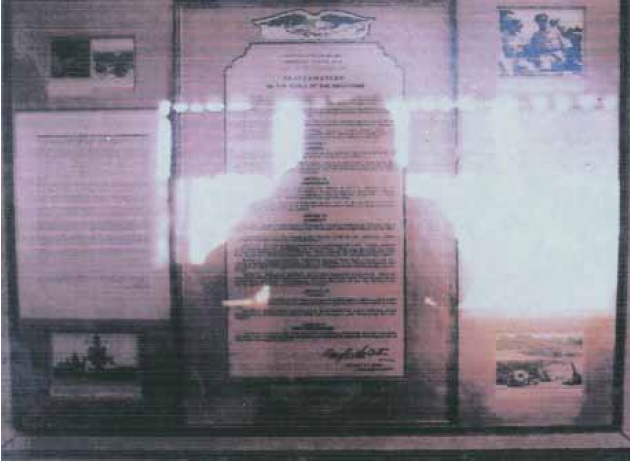Has MacArthur’s proclamation been found?
Like all members of the United States Marine Corps, Unisan Soriano Madayag has a tattoo of its motto “Semper Fi” on his right upper arm. Semper Fi is a contraction of the Latin words “Semper Fidelis,” meaning “Always Faithful.”
Madayag of San Jose, Occidental Mindoro, was 10 in 1971 when he went to the United States to join his father Apolinario.
The elder Madayag had been in the US since 1968 and worked as a doorman and later cashier in a theater in South San Francisco. The son continued his studies at Everett Junior School and at Balboa High.
In November 1983, Madayag joined the US Marines and did duty with the 3rd Division in Okinawa, Japan. But he did not stay in the service long and was discharged in 1990.
He went to work at California Pacific Hospital as a transporter.
In December 1999, while Madayag was doing his laundry in one of the laundry shops in South San Francisco, an old American saw his Semper Fi tattoo. The man asked if Madayag was Filipino, and when he learned that he was, the former introduced himself as Joe, a retired Army officer.
In their second meeting at the laundry shop two weeks later, Joe told Madayag he had an important document to show him at their next meeting. True enough, Joe showed Madayag the contents of an ordinary box—a 3.5-inch by 4.5-inch frame with three printed documents on its face.
Eagle on top
At the center of the frame, with an image of an American eagle at the top, was an undated General Douglas MacArthur’s Proclamation of Freedom to the People of the Philippines. To its left was a document titled “In Commemoration” and to its right was an “Honor Roll.”
Madayag knew that what he had in his hand were important documents. But he did not know their significance.
Joe asked Madayag if he was interested in owning the framed proclamation. When he said yes, the old man asked him to take care of it. Before the two parted that day in January 2000, the American said: “This is your country’s trophy. Bring it back to the Philippines. Do whatever you want with it. Sell it if you want. But when you sell it, share some with the POWs who are still alive.”
At home, after reading the proclamation and the supporting documents again and again, Madayag carefully examined the frame and dismantled it. At the back of the framed Proclamation, he found a letter. It was titled “The History of the Discovery of General Douglas MacArthur’s Proclamation Document of Freedom to the People of the Philippines” dated May 6, 1984, and signed by Frank H. Dillman, author of “In Commemoration.”
‘In Commemoration’
The proclamation was best described by Sgt. Dillman’s “In Commemoration” dated April 9, 1983, during the 42nd anniversary of the fall of Bataan. In it, Dillman wrote: “On March 2, 1945, Col. George M. Jones, the Rock commander whose troops had just retaken the island, told General of the Army MacArthur: `Sir, I present to you Fortress Corregidor,’ to which the General replied, after surveying the extent of destruction. ‘I see the old flagpole still stands. Have your troops hoist the colors to its peak and let no enemy ever haul them down.”’
Dillman continued: “MacArthur’s return (to the Philippines on Oct. 22, 1944) was marked by the issuance of his now famous Proclamation of Freedom to the People of the Philippines.
The Honor Roll lists all the American and Filipino military units, commanders and their respective Army serial numbers, who participated in the defense of Bataan, Corregidor and the Philippines.
In Dillman’s letter, the Marine sergeant said the replica of the original proclamation was one of the few enlarged replicas that were posted outside MacArthur’s headquarters in Manila.
Liberation of Manila
A story has it that a year or two after the liberation of Manila in February 1945, an unidentified Filipino soldier removed the proclamation from outside MacArthur’s headquarters and brought it to the United States in 1948. There, he presented it to the Leyte American Legion Post in San Diego. The then president of the San Diego Council of the Navy League, retired Rear Admiral M.C. Cook, recognized the historical significance of the document.
The Navy League, according to Dillman, spent over $2,000 preserving and framing it.
The proclamation gave Madayag more questions than answers. He went back to the laundry shop more often to await the return of the old man to ask him more questions. But the old man never showed up.
Madayag went home to the Philippines in 2003 with the document. He decided to continue his research for the proclamation.
No one at UST, University of the Philippines, Ayala Museum or Camp Aguinaldo knew that such a document existed. Lt. Col. Artemio Matibag, president of the Corregidor Foundation, who knew about it, told Madayag that what he held was an authentic copy.
At UP, Madayag met Ricardo Trota Jose, a history professor, who asked for time to study the document. When Madayag returned two months later, Jose issued a written declaration on Sept. 2, 2011, that said, “This document appears to be the genuine original print of a rare proclamation by General Douglas MacArthur issued around 1944.”
“General MacArthur had published three or four proclamations that were well known; one has actually been cited in Philippine Supreme Court decisions. This particular printed proclamation, however, seemed to be very rare. Other proclamations were printed on letter-size paper; this one got larger and was probably meant for greater public exposure,” Jose said.
Madayag is willing to sell the document so he can help the surviving Filipino veterans, many of whom live in poverty, and follow what old Joe had wanted him to do.
(Rodolfo Meim Acebes is a retired civil servant with the National Bureau of Investigation. He lives in San Jose, Occidental Mindoro, and may be contacted at 0947-3567836.)















